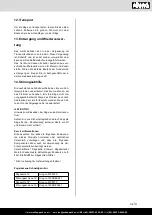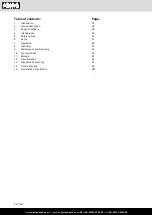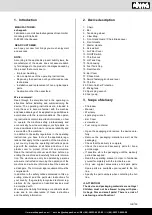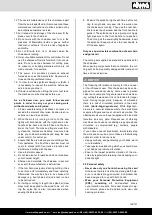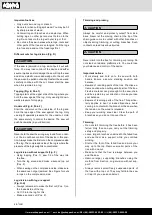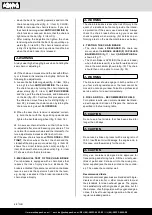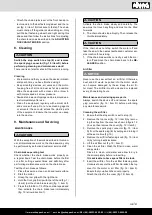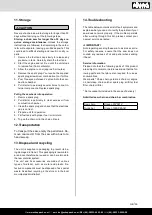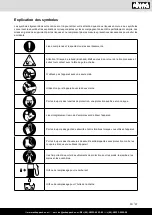
www.scheppach.com /
+(49)-08223-4002-99 /
+(49)-08223-4002-58
GB | 45
Felling of large trees - only with relevant training
(from 15cm diameter)
The undercutting method is used for felling large
trees. For this, a wedge is cut out from the side of the
tree according to the required falling direction. After
the dropping cut has been made on the other side of
the tree, it will fall in the direction of the wedge cut.
m
NOTICE
If the tree has large prop/buttress roots, these should
be removed before the wedge is cut. If the saw is
used for removing the prop/buttress roots, the saw-
chain should not touch the ground so the chain does
not become blunt.
Undercut and felling the tree (Fig. B-C)
•
For the undercut, first cut the upper part (Pos. 1)
of the wedge (Pos. 2). Cut 1/3 of the way into the
tree. Then saw the lower part (Pos. 3) of the wedge
(Pos. 2). Now remove the wedge you have cut out.
•
Afterwards, you can carry out the dropping cut on
the opposite side of the tree (Fig. 4). For this, start
about 5cm above the middle of the cut. In this way,
there is enough wood between the dropping cut
(Pos. 4) and the wedge (Pos. 2) so that it functions
as a hinge. This hinge is designed to guide the tree
in the right direction when falling.
m
NOTICE
Before completing the dropping cut, if required, in-
crease the cut using wedges to control the direction
of the fall. Exclusively use wood or plastic wedges.
Steel or iron wedges can cause kickback and dam-
age to the device.
• Be aware of signs that the tree is beginning to
fall: Cracking sounds, the dropping cut opening or
movement in the upper branches.
•
When the tree begins to fall, stop the saw, put it
down and leave immediately via your escape route.
•
To prevent injuries, do not cut partly felled trees
with your saw. Beware especially of partly felled
trees which are not supported. If a tree does not
fall down completely, remove the saw and help
the process along with a cable winch, a pulley or
a towing vehicle.
Sawing a felled tree (log division)
The term „log division“ describes the cutting up of a
felled tree into logs of the desired length.
m
CAUTION
Do not stand on the log you are currently cutting.
The log could roll away and you may lose your foot
-
ing and control of the device. Do not carry out sawing
work on sloping ground.
•
Always watch the tip of the bar. Take care when
continuing cuts which have already been started.
• Start the cut with the chainsaw running!
•
Always sharpen the saw chain correctly. Pay par
-
ticular attention to the depth limiter being at the
correct height!
• Never cut through several branches at the same
time! When removing branches, ensure that no
other branch is touched.
•
When cutting to length, pay attention to closely ad
-
jacent branches.
Felling trees - only with relevant training
m
CAUTION
Watch out for broken or dead branches which may
fall down during sawing and which could cause se-
vere injuries. Do not saw close to buildings or power
lines if you do not know in which direction the felled
tree will fall. Do not work at night because you can
see less well, or during rain, snow and storms be-
cause the direction in which the tree will fall cannot
be anticipated.
•
Plan your work with the chainsaw in advance.
• The working environment around the tree should
be cleared so you have secure footing.
•
The machine operator should always be positioned
at a higher level in the working area because the
tree will probably roll or slide down after felling.
The following conditions can influence the tree‘s
falling direction:
•
Wind direction and speed
• Leaning of the tree - The leaning direction cannot
always be recognised because of uneven or slop
-
ing ground. Determine the leaning direction of the
tree using a plumb line or a level.
•
Branches growing (and therefore weight) only on
one side
• Surrounding trees or obstacles
Look out for destroyed or decayed parts of the
tree.
If the trunk is decayed, it can suddenly break and fall
on you. Make sure there is sufficient space for the
falling tree. Keep a distance of 2½ tree lengths to the
next person or other objects. The sound of the motor
can drown out warning cries.
Remove dirt, stones, loose bark, nails, brackets and
wire from the sawing area.
m
Ensure you have a free escape route (Fig. A)
Position 1: Escape route
Position 2: Falling direction of the tree
Содержание 5910113903
Страница 6: ...www scheppach com service scheppach com 49 08223 4002 99 49 08223 4002 58 6 26 5 27 28 29 30...
Страница 33: ...www scheppach com service scheppach com 49 08223 4002 99 49 08223 4002 58 DE 33...
Страница 34: ...www scheppach com service scheppach com 49 08223 4002 99 49 08223 4002 58 34 DE...
Страница 37: ...www scheppach com service scheppach com 49 08223 4002 99 49 08223 4002 58 GB 37 Start Stop manual Mixing ratio...
Страница 134: ...www scheppach com service scheppach com 49 08223 4002 99 49 08223 4002 58 134 NL Start Stop hendel Mengverhouding...
Страница 159: ...www scheppach com service scheppach com 49 08223 4002 99 49 08223 4002 58 PL 159 D wignia Start Stop Stosunek mieszania...
Страница 207: ...www scheppach com service scheppach com 49 08223 4002 99 49 08223 4002 58 HU 207 Ind t Le ll t kar Kever si ar ny...
Страница 231: ...www scheppach com service scheppach com 49 08223 4002 99 49 08223 4002 58 SK 231 P ka tart stop Mie ac pomer...
Страница 251: ...www scheppach com service scheppach com 49 08223 4002 99 49 08223 4002 58 251...

